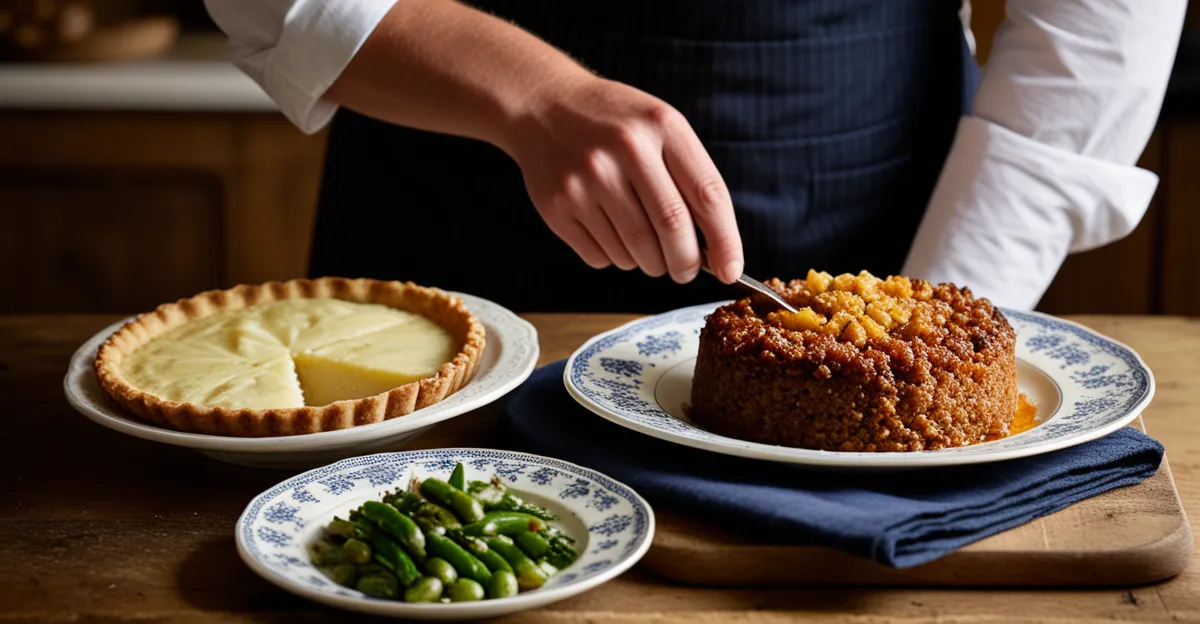Overview of Traditional British Recipes
Traditional British recipes are a testament to the rich culinary history and cultural tapestry of the UK. These dishes not only reflect the nation’s gastronomic past but also embody the cultural significance ingrained in everyday life. Some of the most iconic traditional dishes include fish and chips, shepherd’s pie, and roast beef. Each dish offers a glimpse into the historical moments and regional bounties that shaped them.
The historical context of British recipes can be traced back to various influences, such as Roman and Norman conquests, which brought new ingredients and preparation techniques. For instance, the tradition of roasting meats on spits dates back to medieval times, highlighting the evolution of cooking practices.
Topic to read : What are the top tips for creating a hearty English breakfast?
Moreover, preserving this culinary heritage is essential not only for maintaining cultural identity but also for appreciating the innovations over the centuries. While tradition holds a significant place, there is also room for innovation. Modern chefs embrace this heritage while infusing creativity to keep these recipes alive. This delicate balance ensures that traditional dishes remain relevant, allowing them to evolve alongside contemporary tastes.
In essence, traditional British recipes are deeply woven into the nation’s cultural fabric, offering delicious insights into its rich history and the enduring importance of respectful innovation.
Also read : What are the best techniques for cooking a savory beef Wellington?
Identifying Key Ingredients in Traditional Recipes
To truly appreciate the essence of traditional British recipes, we must delve into the key ingredients that define them. These ingredients are not just the building blocks of flavor but are also steeped in culinary traditions.
Staple Ingredients in Classic British Cooking
British cuisine boasts a variety of staple ingredients, such as beef, lamb, potatoes, and flour, which are used predominantly in dishes like roast beef and shepherd’s pie. Their availability and regional abundance have entrenched them into the national culinary identity.
Regional Variations
Interestingly, regional distinctions influence the choice of ingredients. For instance, Wales is renowned for its lamb due to its rich pastures, while Scottish fare often features oats and barley. Such variations offer a delightful array of flavor profiles and textural uniqueness, enriching the culinary landscape.
Contribution to Flavor and Texture
The key ingredients not only offer nourishment but also define the dish’s character. For example, the marbling in beef contributes to the juicy texture of a roast, while the starchiness of King Edward potatoes is ideal for creamy mashes. Understanding these components is crucial for crafting truly authentic traditional British dishes.
Modernizing Techniques in Traditional Cooking
As the culinary world continues to evolve, so do the cooking techniques used to prepare traditional British dishes. By comparing traditional methods with modern ones, we highlight how these approaches can transform classic recipes. Traditionally, methods such as roasting, boiling, and stewing were staples, deeply rooted in generations of cooking traditions.
However, innovative preparation methods now offer exciting alternatives. Consider sous-vide cooking, which involves vacuum-sealing and slow-cooking ingredients in a water bath. This technique preserves flavors and nutrients, offering a contemporary spin on meat dishes that rivals traditional roasting. Meanwhile, air frying introduces a healthier option by using hot air circulation to achieve the crispiness of fried foods without excessive oil.
These innovative approaches not only influence the outcome of dishes but allow for a greater range of textures and flavors. The introduction of new technologies in the kitchen empowers chefs and home cooks alike to experiment while maintaining the essence of traditional recipes. This harmonious blending of old and new cooking techniques revitalizes beloved British dishes, ensuring they remain enjoyable and relevant for future generations.
Creative Twists on Classic Dishes
In the vibrant world of culinary innovation, recipe adaptations breathe new life into traditional British dishes. These modern variations blend age-old flavors with contemporary flair, creating exciting reinterpretations of beloved classics.
Examples of such innovative twists abound. Take the classic shepherd’s pie: while traditionally filled with lamb, a modern spin might include spiced lentils for a protein-rich, vegan alternative. Another cherished dish, fish and chips, can be creatively transformed by using panko breadcrumbs to achieve an extra crunchy texture, paired with a tangy lime aioli instead of the conventional tartar sauce.
The infusion of global flavors has also made its mark. For instance, British butter chicken can be elevated with the addition of saffron rice, bringing a fragrant twist. This not only broadens the flavor palette but also makes dishes more vibrant and appealing to diverse palates.
The incorporation of new techniques and exciting presentations enhances the diner’s experience, making the dish both a feast for the eyes and the taste buds. Through these innovations, traditional dishes maintain their essence while embracing the influences of a globalized culinary scene. Each twist honors the dish’s cultural significance while ushering it into a modern culinary evolution.
Substituting Ingredients for Contemporary Diets
In today’s culinary landscape, dietary preferences and health considerations play a pivotal role in shaping how we adapt traditional British recipes. As more people embrace gluten-free, vegan, or other dietary lifestyles, ingredient substitutions become vital for maintaining the dish’s flavor and integrity while catering to diverse needs.
Common dietary restrictions include gluten intolerance and dairy allergies. To address these, traditional dishes such as Yorkshire pudding can be made with a gluten-free flour blend. Similarly, a luscious vegan version of classic beef Wellington can be crafted using plant-based imitation meats and dairy-free puff pastry. These swaps ensure that the essence of the dish is preserved, allowing a wider audience to enjoy British culinary staples.
Health consciousness also influences ingredient choices, encouraging the use of healthier alternatives. For instance, replacing traditional lard or butter with heart-healthy oils like olive or avocado oil can result in a lighter, yet flavorful, pastry. This approach not only fits dietary needs but also enhances the nutritional profile of everyday meals.
Ultimately, ingredient substitutions reflect a broader trend towards accommodating contemporary diets without sacrificing the beloved flavors of traditional British cuisine. By doing so, we ensure that cherished dishes continue to thrive in an ever-evolving dietary landscape.
Seasonal and Local Ingredients in Modern Cooking
Incorporating seasonal ingredients into traditional British recipes not only enhances flavor but also supports sustainability. Their use aligns with local growing cycles, ensuring fresh produce while reducing carbon footprints. For example, seasonal ingredients like asparagus and strawberries thrive during spring and summer, allowing their natural sweetness and crispness to shine in dishes like Eton mess or pies.
When recipes are adapted to include local sourcing, they reflect the region’s distinct culinary traditions and flavor profiles. Local sourcing ensures ingredients are at their peak freshness and supports community farmers. Consider the robust flavor of Scottish lamb or the tangy note of Kentish apples, both staples in their respective regional dishes.
Utilizing seasonal ingredients in traditional recipes not only preserves their essence but revitalizes them with modern values. By incorporating local and seasonal produce, chefs contribute to a vibrant culinary evolution that respects both tradition and the environment.
Step-by-Step Guides for Modern Recipes
In an era where precision and clarity reign supreme in culinary creations, cooking guides play a pivotal role in aiding both novice cooks and seasoned chefs to successfully bring recipe instructions to life. The importance of clear instructions cannot be overstated; they are essential for ensuring that the end result stays true to the intended dish while encouraging experimentation and creativity.
Creating engaging content with detailed step-by-step breakdowns allows readers to follow along with ease, reducing anxiety and boosting confidence. Each step should be articulated clearly, incorporating user-friendly formats that cater to diverse learning styles. These formats often include visual aids such as photographs illustrating key stages of the cooking process, making it simpler for users to replicate techniques accurately.
Additionally, multimedia elements like video tutorials can further enhance learning by providing a dynamic and interactive experience. These resources offer invaluable instruction on nuances such as timing, texture checks, and presentation, ensuring even complex modern recipes are accessible and achievable.
By prioritizing comprehensive and straightforward guides, the culinary adventure becomes an inviting journey rather than a daunting task, leading to delectable outcomes and a rewarding cooking experience.
Cultural Context and Relevance of Modernized Recipes
In today’s culinary landscape, understanding the cultural significance of recipes is pivotal, particularly as they reflect evolving food trends. Modernized recipes have adapted to an era of rapid change, where culinary evolution meets tradition. By breathing new life into traditional British recipes, we capture contemporary tastes and broaden appeal, while still honoring rich culinary heritages.
The role of social media and culinary influencers is instrumental in shaping these trends. Platforms like Instagram and TikTok provide a stage for creative chefs to showcase innovative dishes, leading to widespread popularity and influence on recipe adaptation. This dynamic drives the push for both visual and flavor innovation, crafting dishes that are as Instagram-worthy as they are delicious.
Moreover, the evolving identity of British cuisine is marked by a delightful fusion of heritage and modern influences. By incorporating global ingredients and cooking techniques, chefs create dishes that cater to diverse palates, yet maintain the essence of traditional recipes. This fusion is not only reflective of globalization but also invites an enriched understanding of British culinary practices.
As food trends continue to shift, the relevance of modernized recipes in cultural preferences becomes ever more apparent. They serve as a bridge, connecting past traditions to future innovations, and encapsulating the ever-evolving story of food in our lives.











